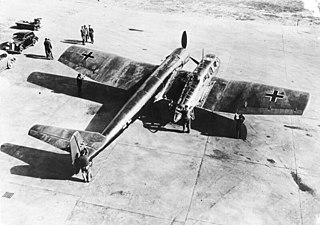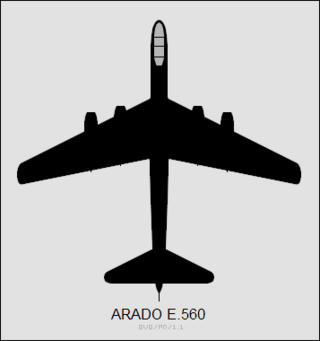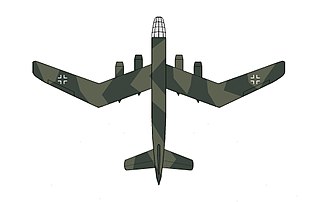Related Research Articles

The Blohm & Voss BV 238 was a German flying boat, built during World War II. It was the heaviest aircraft ever built when it first flew in 1944, and was the largest aircraft produced by any of the Axis powers during World War II.

The Blohm & Voss BV 141 was a World War II German tactical reconnaissance aircraft, notable for its uncommon structural asymmetry. Although the Blohm & Voss BV 141 performed well, it was never ordered into full-scale production, for reasons that included the unavailability of the preferred engine and competition from another tactical reconnaissance aircraft, the Focke-Wulf Fw 189.
The Blohm & Voss BV 144 was an advanced twin-engined commercial airliner developed by Germany during World War II but intended for post-war service. It was unusual in having a variable-incidence wing. Two prototypes were built by Breguet in France.
The Blohm & Voss P 178 was a German jet-powered dive bomber/fighter-bomber of unusual asymmetric form, proposed during World War II.

The Blohm & Voss P 194 was a German design for a mixed-power Stuka or ground-attack aircraft and tactical bomber, during World War II.

The Blohm & Voss Ha 140 was a German multi-purpose seaplane first flown in 1937. It was intended for use as a torpedo bomber or long-range reconnaissance aircraft but did not enter production.
Asymmetrical aircraft have left- and right-hand sides which are not exact mirror images of each other. Although most aircraft are symmetrical, there is no fundamental reason why they must be, and design goals can sometimes be best achieved with an asymmetrical aircraft.

The Arado E.560 was a series of multi-engined Arado medium-range tactical bombers projected during the Second World War.

The Blohm & Voss P 170 was a three-engined unarmed fast bomber and ground-attack aircraft project proposed by the aircraft manufacturer Blohm & Voss to the Luftwaffe during the Second World War.

The Blohm & Voss Bv P 188 was a long-range, heavy jet bomber design project by the Blohm & Voss aircraft manufacturing division during the last years of the Third Reich. It featured a novel W-wing planform with variable incidence.
The Blohm & Voss BV 237 was a German proposed dive bomber with an unusual asymmetric design based on the Blohm & Voss BV 141.

The Gotha Go P.60 was a jet-powered flying wing fighter proposed during World War II by Gothaer Waggonfabrik (Gotha). It was conceived as an improved derivative of the single-seat Horten Ho 229, which Gotha had begun to manufacture as the Go 229. The initial concept a two-seat multi-role fighter that was subsequently developed into a three-seat night and all-weather fighter, but no variant was ever built.
The Blohm & Voss P 163 was a design project for an unconventional bomber during World War II. Constructed mainly from steel, its crew were accommodated in large wingtip nacelles, giving it a triple-fuselage appearance. Its propeller drive system was also unusual, with the central fuselage containing twin engines coupled to a front-mounted contra-prop.
The Blohm & Voss P 203 was a design project for a heavy fighter during World War II. Capable of filling the roles of night fighter, light bomber and ground-attack, it had mixed propulsion, having both piston engine driven propellers and jet engines.
The Blohm & Voss P 209 was one of a series of single-engined jet fighter design studies. Under development in the latter half of 1944, when the single-engined jet fighter requirement was issued the P 209 was radically revised to meet the deadline but was not taken further by the RLM.
The Blohm & Voss P 196 was the last of Blohm & Voss's World War II design projects for a "stuka" dive bomber and close support aircraft to replace the aging Junkers Ju 87.
The Blohm & Voss P 198 was a design project during World War II for a single-seat high-altitude jet fighter.
The Blohm & Voss P.202 was an unusual design study for a variable-geometry jet fighter during World War II. It was the first design to incorporate a slewed wing in which one side swept forward and the other back. The P.202 was never built or flown.

The Blohm & Voss P 184 was a German design for a long-range reconnaissance aircraft during World War II. Carrying a crew of five, it was of aerodynamically clean appearance and its wing had an unusually high aspect ratio.
References
Notes
Bibliography
- David Masters; German Jet Genesis, Jane's, 1982, p.
- Dan Sharp; Luftwaffe: Secret Jets of the Third Reich, Mortons 2015, pp.